Lophotrochozoans - Study guides, Class notes & Summaries
Looking for the best study guides, study notes and summaries about Lophotrochozoans? On this page you'll find 13 study documents about Lophotrochozoans.
All 13 results
Sort by
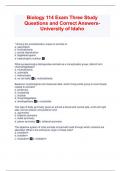
-
Biology 114 Exam Three Study Questions and Correct Answers-University of Idaho
- Exam (elaborations) • 7 pages • 2024
-
Available in package deal
-
- $8.99
- + learn more
**Among the characteristics unique to animals is: a. gastrulation b. multicellularity c. sexual reproduction d. flagellated sperm e. heterotrophic nutrition What synapomorphy distinguishes animals as a monophyletic group, distinct form choanoflagellates? a. multicellularity b. coloniality c. heterotrophy d. no cell walls a. multicellularity Based on morphological and molecular data, which living protist group is most closely related to animals? a. poriferans b. nucleariids c. chytrids d. choa...
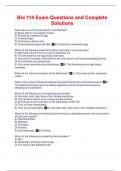
-
Bio 114 Exam Questions and Complete Solutions
- Exam (elaborations) • 8 pages • 2024
-
Available in package deal
-
- $8.99
- + learn more
What was one of the innovations of the Reptilia? A) Being able to live outside of water. B) Producing a waterproof egg. C) Powered flight. D) Producing a spinal cord. E) Producing pharyngeal gill slits. B) Producing a waterproof egg. Which of the following statements about mammals is most accurate? A) Mammals were the first to evolve a post-anal tail. B) The Monotremes are egg-laying mammals. C) Among the Chordata, mammals are the only ones to not have pharyngeal gill slits. D) All mammals are ...
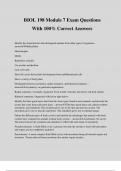
-
BIOL 198 Module 7 Exam Questions With 100% Correct Answers
- Exam (elaborations) • 18 pages • 2024
- Available in package deal
-
- $12.49
- + learn more
BIOL 198 Module 7 Exam Questions With 100% Correct Answers Identify the characteristics that distinguish animals from other types of organisms. - answerMulticellular Heterotrophic Motile Reproduce sexually Use aerobic metabolism Lack cell walls Have life cycles that include development from undifferentiated cells Have a variety of body plans Distinguish between asymmetry, radial symmetry, and bilateral symmetry. - answerAsymmetry: no particular organization Radial symmetry: Circular...
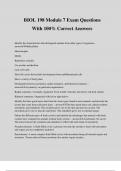
-
BIOL 198 Module 7 Exam Questions With 100% Correct Answers
- Exam (elaborations) • 18 pages • 2024
-
- $12.49
- + learn more
BIOL 198 Module 7 Exam Questions With 100% Correct Answers Identify the characteristics that distinguish animals from other types of organisms. - answerMulticellular Heterotrophic Motile Reproduce sexually Use aerobic metabolism Lack cell walls Have life cycles that include development from undifferentiated cells Have a variety of body plans Distinguish between asymmetry, radial symmetry, and bilateral symmetry. - answerAsymmetry: no particular organization Radial symmetry: Circular...
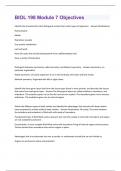
-
BIOL 198 Module 7 Objectives Questions & Answers Already Passed!!
- Exam (elaborations) • 19 pages • 2024
- Available in package deal
-
- $6.79
- + learn more
Identify the characteristics that distinguish animals from other types of organisms. - Answer-Multicellular Heterotrophic Motile Reproduce sexually Use aerobic metabolism Lack cell walls Have life cycles that include development from undifferentiated cells Have a variety of body plans Distinguish between asymmetry, radial symmetry, and bilateral symmetry. - Answer-Asymmetry: no particular organization Radial symmetry: Circularly organized. If cut in half vertically, the halves will loo...

-
Campbell Biology Chapter 33 Study Guide with Complete Solutions
- Exam (elaborations) • 13 pages • 2024
-
- $9.99
- + learn more
Campbell Biology Chapter 33 Study Guide with Complete Solutions Invertebrates - Answer️️ -Animals without a backbone. About 95% of known animal species. Calcarea and Silicea - Answer️️ -phylum that includes sponges; no symmetry, tissues, body cavity, organs, nervous system; basal animals; mostly marine; contain spicules; most are hermaphrodites; free-swimming during larval stage and sessile (non motile) as adults; suspension/filter feeders Suspention feeders - Answer️️ -small...
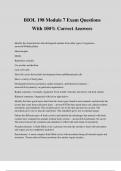
-
BIOL 198 Module 7 Exam Questions With 100% Correct Answers
- Exam (elaborations) • 18 pages • 2024
-
- $12.49
- + learn more
BIOL 198 Module 7 Exam Questions With 100% Correct Answers Identify the characteristics that distinguish animals from other types of organisms. - answerMulticellular Heterotrophic Motile Reproduce sexually Use aerobic metabolism Lack cell walls Have life cycles that include development from undifferentiated cells Have a variety of body plans Distinguish between asymmetry, radial symmetry, and bilateral symmetry. - answerAsymmetry: no particular organization Radial symmetry: Circular...
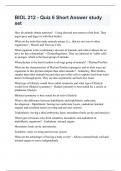
-
BIOL 212 - Quiz 6 Short Answer study set
- Exam (elaborations) • 4 pages • 2024
-
- $14.49
- + learn more
How do animals obtain nutrients? - Using directed movement to find food. Then ingest prey and digest it with their bodies. What are the traits that make animals unique (i.e., that are not seen in other organisms)? - Muscle and Nervous Cells What organism is the evolutionary ancestor of animals, and what evidence do we have for this relationship? - Choanoflagellates. They are identical to "collar cells" in sponges, which is the basal group of animals. What phylum is the basal (earliest evolv...

-
Exam (elaborations) Biology
- Exam (elaborations) • 8 pages • 2024
-
- $7.99
- + learn more
Invertebrates️️Animals without a backbone. About 95% of known animal species. Calcarea and Silicea️️phylum that includes sponges; no symmetry, tissues, body cavity, organs, nervous system; basal animals; mostly marine; contain spicules; most are hermaphrodites; free-swimming during larval stage and sessile (non motile) as adults; suspension/filter feeders Suspention feeders️️small and large organisms that use filtering and trapping techniques to collect minute food particles su...
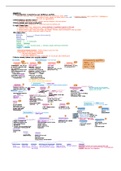
-
Exam review (of Kingdom Animalia with organization)
- Summary • 2 pages • 2022
-
- $10.49
- + learn more
I have color coded and organized the groups of animals into protostomes, deuterostomes, and the phylum within along with important characteristics. There is also information on thermoregulation within the animals and maintaining homeostasis.

Did you know that on average a seller on Stuvia earns $82 per month selling study resources? Hmm, hint, hint. Discover all about earning on Stuvia


